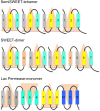Functional role of oligomerization for bacterial and plant SWEET sugar transporter family
- PMID: 24027245
- PMCID: PMC3785766
- DOI: 10.1073/pnas.1311244110
Functional role of oligomerization for bacterial and plant SWEET sugar transporter family
Abstract
Eukaryotic sugar transporters of the MFS and SWEET superfamilies consist of 12 and 7 α-helical transmembrane domains (TMs), respectively. Structural analyses indicate that MFS transporters evolved from a series of tandem duplications of an ancestral 3-TM unit. SWEETs are heptahelical proteins carrying a tandem repeat of 3-TM separated by a single TM. Here, we show that prokaryotes have ancestral SWEET homologs with only 3-TM and that the Bradyrhizobium japonicum SemiSWEET1, like Arabidopsis SWEET11, mediates sucrose transport. Eukaryotic SWEETs most likely evolved by internal duplication of the 3-TM, suggesting that SemiSWEETs form oligomers to create a functional pore. However, it remains elusive whether the 7-TM SWEETs are the functional unit or require oligomerization to form a pore sufficiently large to allow for sucrose passage. Split ubiquitin yeast two-hybrid and split GFP assays indicate that Arabidopsis SWEETs homo- and heterooligomerize. We examined mutant SWEET variants for negative dominance to test if oligomerization is necessary for function. Mutation of the conserved Y57 or G58 in SWEET1 led to loss of activity. Coexpression of the defective mutants with functional A. thaliana SWEET1 inhibited glucose transport, indicating that homooligomerization is necessary for function. Collectively, these data imply that the basic unit of SWEETs, similar to MFS sugar transporters, is a 3-TM unit and that a functional transporter contains at least four such domains. We hypothesize that the functional unit of the SWEET family of transporters possesses a structure resembling the 12-TM MFS structure, however, with a parallel orientation of the 3-TM unit.
Keywords: evolution; transporter structure.
Conflict of interest statement
The authors declare no conflict of interest.
Figures









References
-
- Walmsley AR, Barrett MP, Bringaud F, Gould GW. Sugar transporters from bacteria, parasites and mammals: Structure-activity relationships. Trends Biochem Sci. 1998;23(12):476–481. - PubMed
-
- Rogers K. Bacteria and Viruses. New York: Britannica Educational Publishing; 2011.
-
- Lalonde S, Wipf D, Frommer WB. Transport mechanisms for organic forms of carbon and nitrogen between source and sink. Annu Rev Plant Biol. 2004;55:341–372. - PubMed
-
- Chen LQ, et al. Sucrose efflux mediated by SWEET proteins as a key step for phloem transport. Science. 2012;335(6065):207–211. - PubMed
-
- Abramson J, et al. Structure and mechanism of the lactose permease of Escherichia coli. Science. 2003;301(5633):610–615. - PubMed
Publication types
MeSH terms
Substances
LinkOut - more resources
Full Text Sources
Other Literature Sources
Molecular Biology Databases

